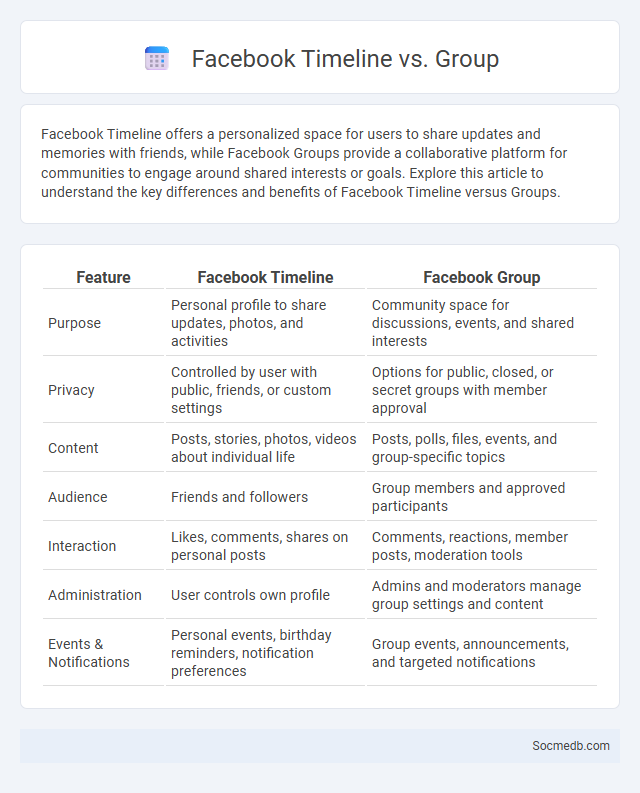
Photo illustration: Facebook Timeline vs Group
Facebook Timeline offers a personalized space for users to share updates and memories with friends, while Facebook Groups provide a collaborative platform for communities to engage around shared interests or goals. Explore this article to understand the key differences and benefits of Facebook Timeline versus Groups.
Table of Comparison
| Feature | Facebook Timeline | Facebook Group |
|---|---|---|
| Purpose | Personal profile to share updates, photos, and activities | Community space for discussions, events, and shared interests |
| Privacy | Controlled by user with public, friends, or custom settings | Options for public, closed, or secret groups with member approval |
| Content | Posts, stories, photos, videos about individual life | Posts, polls, files, events, and group-specific topics |
| Audience | Friends and followers | Group members and approved participants |
| Interaction | Likes, comments, shares on personal posts | Comments, reactions, member posts, moderation tools |
| Administration | User controls own profile | Admins and moderators manage group settings and content |
| Events & Notifications | Personal events, birthday reminders, notification preferences | Group events, announcements, and targeted notifications |
Introduction to Facebook Timeline and Groups
Facebook Timeline offers a dynamic way to showcase personal stories, photos, and life events in chronological order, allowing users to share their experiences with friends and family seamlessly. Facebook Groups provide a space for communities to connect, engage, and collaborate around shared interests, fostering communication through posts, comments, and event organization. Together, Timelines and Groups enhance social networking by combining personal expression with collective interaction.
Key Features of Facebook Timeline
Facebook Timeline showcases your life events, photos, and posts in a chronological order, making it easy to navigate your digital history. You can customize privacy settings for each post, ensuring your content reaches the right audience. Interactive features like tagging friends, adding location, and highlighting important milestones enhance your social media experience.
Key Features of Facebook Groups
Facebook Groups offer robust community-building tools including customizable privacy settings that allow administrators to control membership access and content visibility. Interactive features such as polls, events, and photo albums foster engagement and facilitate organized discussions among members. The platform also integrates moderation tools like post approval and member management to maintain a safe and focused group environment.
Privacy Differences: Timeline vs Group
Social media platforms handle privacy differently between Timeline and Group settings, affecting content visibility and user interaction. Your Timeline posts are typically public or visible to friends, allowing broader audience engagement, while Group posts can be restricted to members only, enhancing privacy and targeted communication. Understanding these privacy distinctions helps you control who accesses your shared information effectively.
Content Sharing: Timeline vs Group
Content sharing on social media varies significantly between timelines and groups, influencing audience reach and interaction. Timelines primarily facilitate public sharing to a broad audience, enhancing visibility and engagement through real-time updates and diverse follower networks. Groups offer a more focused environment for sharing, fostering community interaction and targeted discussions with members who share specific interests or affiliations.
Audience Engagement on Timeline and Group
Maximizing audience engagement on your social media timeline and within groups requires consistent, targeted content that resonates with your followers' interests and behaviors. Interactive posts, such as polls, questions, and live videos, stimulate participation and foster a sense of community, increasing visibility through algorithmic preference. Tracking engagement metrics like comments, shares, and reactions provides actionable insights to refine your strategy and enhance your connection with your audience.
Use Cases: When to Use Timeline
Timeline on social media is ideal for showcasing your brand's story, highlighting key events, and sharing chronological updates that engage your audience effectively. It allows you to organize content around significant dates, making it easier for followers to track progress and milestones. Your timeline can boost user interaction by providing a clear, time-based narrative that enhances the overall user experience.
Use Cases: When to Use Group
Group features on social media platforms enhance collaboration by allowing You to connect with like-minded individuals sharing specific interests or goals. Use Groups for organizing events, sharing niche content, or fostering community support that requires focused interaction. These dedicated spaces streamline communication, making it ideal for professional networking, hobbyist discussions, or educational purposes.
Managing and Moderating Timelines vs Groups
Managing and moderating social media timelines involves curating content feeds to ensure relevance, appropriateness, and engagement, often requiring real-time filtering of posts and comments. In contrast, moderating groups focuses on fostering community interaction, enforcing group rules, and managing member participation to maintain a positive environment. Your approach should balance timely oversight on timelines with proactive community-building strategies within groups to optimize user experience.
Choosing the Best Option: Timeline or Group
Choosing between a social media timeline and a group depends on your engagement goals and audience interaction preferences. Timelines offer a dynamic, real-time flow of updates, ideal for spreading information broadly and keeping followers informed. Groups, on the other hand, foster focused discussions and community building, allowing you to create a more intimate space for your audience to connect and share.
 socmedb.com
socmedb.com